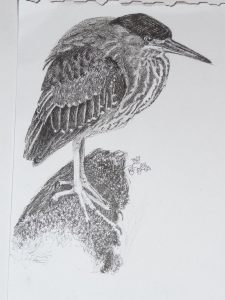Below are further notes on the survey of breeding Curlews in the Severn and Avon Vales in Gloucestershire and Worcestershire, as of mid July. The survey is being carried out because of the increasing realisation that conservation of Curlews (both on breeding sites and in wintering areas) is one of the principal bird conservation issues in UK. Similar breeding surveys have been carried on in other parts of lowland England, as well as on the upland breeding areas throughout UK.
- The nesting season started late because of flooding which continued into mid-April.
- Although the breeding Curlews were quite obvious and vocal (with lots of bubbling song-flights) over their territories in May, they went quiet and became much more difficult to find during June. In June, when the eggs would be expected to hatch, the adults became much more discreet; they often kept out of the way in the long grass, only emerging if you got fairly close to the area of grass where the chicks were presumably located; if they did have chicks, their very agitated calls made this pretty obvious.
- Some birds clearly lost their eggs or young; but the adults seemed to hang about close to the breeding sites, remaining much quieter than birds with young; this makes the picture much more complicated and difficult to interpret.
- Several farmers in the area have contacted me before hay cutting, asking me to check whether there were breeding Curlews on their fields, and offering to delay hay making if breeding Curlews are found with young.
- By mid July, the breeding season is almost over. Several adult Curlews have been seen with full-grown young on hayfields. This rather early date is something of a surprise to me: I thought it was a late year because of the April flooding, but the young seem to be fledging slightly earlier than usual.
- Because of damp, miserable weather in the last couple of weeks, hay cutting has been delayed; this extra period of grace may well have helped more breeding Curlews to bring off their young successfully.
- Curlews will no doubt disappear from the Severn and Avon meadows in the next couple of weeks, moving off to wintering sites on estuaries and round the coast; some birds from further north may be seen moving through. From early August, the focus on Curlew observations will change to the estuary.
- Over the Hasfield/Ashleworth area in Gloucestershire, a Curlew was seen on 6 July, flying high downriver and taking no notice of local breeding birds – probably a bird that had finished the breeding cycle further north and was on its way to the estuary.
- In the same site (where two breeding pairs had been noted throughout the spring and early summer) a very anxious adult male was giving alarm calls over a hayfield on 7 July; it was still there, equally anxious, on 9 July, accompanying two full grown chicks, which could just fly (an early date, it seems to me); by 12 July there was no sign of them and they had probably moved off to wintering areas.
- At Upham Meadow, Twyning (Gloucestershire), where hay cutting is always relatively late, and is staggered (leaving large swathes of uncut hay as a refuge for young Curlews), another anxious male was seen on 15 July, with two flying birds of the year nearby.
- Near Bredon’s Hardwick on the Worcestershire bank of the Avon, another anxious male was found on 16 July and, shortly afterwards, a flying young bird was seen. This is a site recognised by the famer as a regular Curlew breeding field; he had seen a non-flying young Curlew a week earlier, and had therefore not cut the hay over a large part of the field.
- It is probably significant that all three of the above sites are very secluded, with little or no disturbance from visitors (especially dog-walkers).
- At several other sites along the Avon, both in Gloucestershire and Worcestershire, very agitated adults with the characteristic alarm call have been seen in the last ten days; young (flying or not) were not found, but were almost certainly present; the chicks’ natural reaction, even if they can fly, is to crouch in the grass, where they are very difficult to find. So it is thought that at least three other pairs successfully raised young.
- At some sites where breeding attempts had been noted earlier in the season, adult Curlews have been noted, but without the alarm calls and with no sign of anxiety. It is thought that at these sites, the adults had lost eggs or young and were staying on near the site after the failure of their breeding attempt.
- Thus, at the Severn Ham, Tewkesbury, (where a pair successfully brought off chicks last year), the farmers who had hay cutting rights were all ready to delay hay making if young Curlews were found. But although one (perhaps two) pairs of Curlews had tried to nest there, it seems they lost their eggs or young (probably to predators such as fox, crow or badger), so had no chicks by the time of hay making.
- I am sure that there are more pairs that I don’t know about, especially further up the Worcestershire Avon. I would be very pleased to have any more reports on the progress of the season, there or elsewhere.
More long-term issues:
- Mary Colwell, who earlier in the year undertook a 500 mile from Northern Ireland to Lincolnshire to highlight the plight of the Curlew (see page 61 of the latest RSPB magazine, in a broad article on Curlews and other waders), has been back to Gloucestershire, together with Phil Sheldrake of RSPB. We are planning an all-day workshop as a follow-up to Curlew surveys throughout lowland England (and as a prelude to efforts next year), probably on next World Wetland Day, Thursday 2 February 2017; watch this space for further details.
- Despite my limited botanical knowledge, I have been looking more closely at the botany of hay meadows in the Severn and Avon Vales. It seems to me that most Curlews are nesting on herb-rich ancient hay meadows, and that if you look after good hay meadows (a highly legitimate conservation aim in itself), you will protect many of the nesting Curlews (and other ground nesting species too – Skylark, Yellow Wagtail, Corn Bunting – and probably other nesting waders such as Lapwing, Redshank and Snipe, though these tend to prefer rather wetter sites than Curlew). So I shall be talking to county record centres about marshalling botanical data, so that it becomes easier to identify and monitor the best hay meadows in each county (Top Twenty? Top Fifty? Are they all recognised as SSSIs or Key Wildlife sites?).

 Lawrence Skipp, who died in a road accident in the Forest of Dean on 2 July at the age of only 38, was a general naturalist of exceptionally broad interests. I have known him for fifteen years or more, and usually met him in the hides and lanes round the reserves at Ashleworth and Coombe Hill. His base was in the Hartpury/ Tibberton area, and the Severn Vale and the Forest of Dean of the county were the two areas where he was particularly active. I am grateful to his father, Dave, who has provided more details about the life and interests of his son.
Lawrence Skipp, who died in a road accident in the Forest of Dean on 2 July at the age of only 38, was a general naturalist of exceptionally broad interests. I have known him for fifteen years or more, and usually met him in the hides and lanes round the reserves at Ashleworth and Coombe Hill. His base was in the Hartpury/ Tibberton area, and the Severn Vale and the Forest of Dean of the county were the two areas where he was particularly active. I am grateful to his father, Dave, who has provided more details about the life and interests of his son.